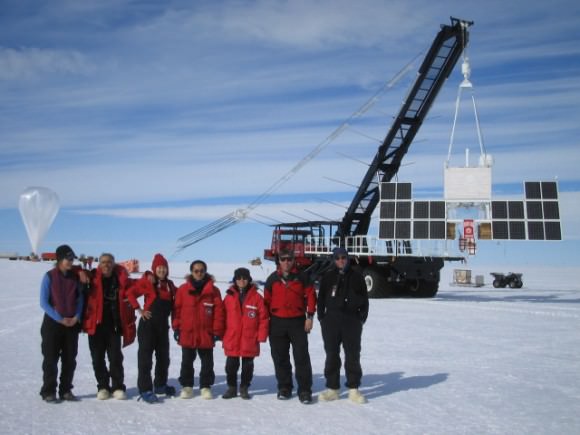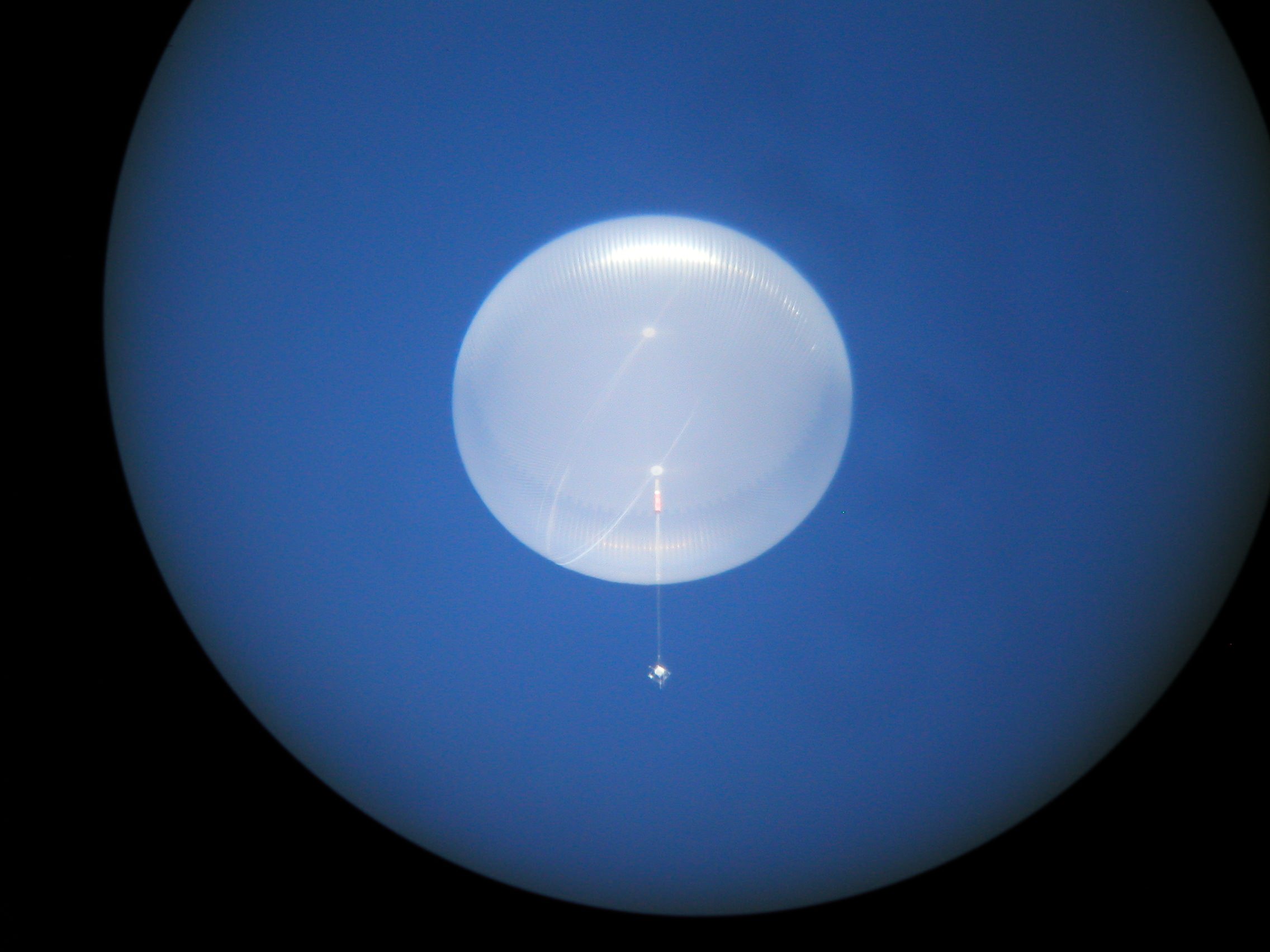[/caption]
High altitude balloons are an inexpensive means of getting payloads to the brink of space, where all sorts of great science and astronomy can be done. A new prototype of balloon that uses material as thin as plastic food wrap was successfully checked out in an 11-day test flight, and this new design may usher in a new era of high altitude flight. NASA and the National Science Foundation sponsored the test, which was launched from McMurdo Station in Antarctica. The balloon reached a float altitude of more than 111,000 feet and maintained it for the entire 11 days of flight. It’s hoped that the super-pressure balloon ultimately will carry large scientific experiments to the edge of space for 100 days or more.
The flight tested the durability and functionality of the scientific balloon’s novel globe-shaped design and the unique lightweight and thin polyethylene film. It launched on December 28, 2008 and returned on January 8, 2009.
“Our balloon development team is very proud of the tremendous success of the test flight and is focused on continued development of this new capability to fly balloons for months at a time in support of scientific investigations,” said David Pierce, chief of the Balloon Program Office at NASA’s Wallops Flight Facility at Wallops Island, Va. “The test flight has demonstrated that 100 day flights of large, heavy payloads is a realistic goal.”
This seven-million-cubic-foot super-pressure balloon is the largest single-cell, super-pressure, fully-sealed balloon ever flown. When development concludes, NASA will have a 22 million-cubic-foot balloon that can carry a one-ton instrument to an altitude of more than 110,000 feet, which is three to four times higher than passenger planes fly. Ultra-long duration missions using the super pressure balloon cost considerably less than a satellite and the scientific instruments flown can be retrieved and launched again, making them ideal very-high altitude research platforms.

In addition to the super pressure test flight, two additional long-duration balloons were launched from McMurdo during the 2008-2009 campaign. The University of Maryland’s Cosmic Ray Energetics and Mass, or CREAM IV, experiment launched December 19, 2008, and landed January 6, 2009. The CREAM investigation was used to directly measure high energy cosmic-ray particles arriving at Earth after originating from distant supernova explosions elsewhere in the Milky Way galaxy. The payload for this experiment was refurbished from an earlier flight. The team released data and their findings from their first flight in August 2008.
The University of Hawaii Manoa’s Antarctic Impulsive Transient Antenna launched December 21, 2008, and is still aloft. Its radio telescope is searching for indirect evidence of extremely high-energy neutrino particles possibly coming from outside our Milky Way galaxy.
Source: NASA


Very Interesting.
Lookming forward to the ANITA results a lot. EeV neutrinos are highly interesting, similar to the highest energy cosmic rays.
A very long time ago in the 1980s I set out in a private paper, Blowing Bubble Structures in Space, (not widely distributed), a proposal for building bubble structures in space as a way of creating very large structures in orbit using the minimum of weight. – In essence, I suggested that it would be possible to blow a very large bubble and then, if you introduced two new ‘bubbles’ inside the first and blew them both at the same time, you would get a flat surface, floor or ceiling depending which way you look at the result with the inner chamber divided into two. Then add more ‘twin’ bubble blowings would allow you to construct any required number of “rooms”. If you blew the original bubble and then blew in a foam to attach to the inner surface and then blew another identical bubble, before you start the division process you can have a multi-layer outer surface that would eventually become strong enough to overcome the structural needs of what could become a very large orbiting facility. Indeed, you would need to carry out inner coatings and then cover them as a way of creating a rigid structure that would withstand the rigours of the use you put them to. But the basic principle is to use the minimum weight by carrying the basic material into space and then carrying out the construction, rather than constructing on Earth and then transporting the structure to orbit.
Taking another tack, you can envisage one very large bubble and then blow your twin internal bubbles, but instead of leaving a flat surface, if you change the pressure of the inner environment of one, you end up with a very large mirror which may be very easily aluminiumised in space to create an astronomical instrument.
These ideas in turn led to my presenting, with the kind help of Alan Jefferson, (at that time Senior Lecturer in the Dept of Aeronautics and Astronautics in the university of Southampton), a detailed proposal for the Orbiting Space Chronometer as an entry for the Tour Eiffel de la Space competition 1986/7 and won an Honourable mention. http://www.jstor.org/pss/1575232
If NASA has discovered a way of blowing these very large balloons as I suspect, from a heated single mass of the plastic used for the structure, then they have made the principle steps towards what I originally aimed at myself.
Something for you all to think about.
For the information of the readers:
(assuming the international foot is used, which is equal to 0.3048 metres)
“altitude of more than 111,000 feet”
altitude of more than (about) 33.5 km.
“22 million-cubic-foot balloon”
balloon with a volume of (about) 623,000 m^3.
“can carry a one-ton instrument”
Short ton, long ton, metric ton? I don’t know.
Thank you very much, Miss Atkinson 😉
Could they not use this type of baloon to land a shuttle on mars?
I wonder what happens to the balloon- is it fully recovered, or are pieces of it left to drift, or what?
As to the units and accuracy used in the piece, close enough as far as I am concerned. Nancy is reliable and if you want more sigfigs then click on the links.
To chime in on Don Alexander’s previous post, I can foresee all manner of astrophysical research requiring high altitude, long duration platforms for instrumentation perfectly suited for the capabilities of balloon-borne missions. And as noted, balloon borne experiments are a much more economical alternative to satellite missions. Great story Nancy.(And, EeV neutrinos ARE pretty cool!)
A few basic dumb questions for the scientifically impaired.
Since the title of the article highlights the “super-thin” material, can you shed a little more light on what the advantage of that is ?
I would assume it allows for more altitude. How does the 110,000 foot altitude compare to the altitudes of current balloons.
What does the higher altitude enable scientifically. Is there a holy grail altitude scientists would like to acheive. Thanks !
Confusing… 110,000 feet is about 15 miles short of the record. And the duration of 11 days is about 1 month short of the record there also. So what exactly did this balloon do that is newsworthy?
Balloons were doing the exact same thing in the late 1950s. Just FYI.
They nicked my idea! Still at least they’re making it work.
My plan was to use a hydrogen baloon to get to 100,000′ for free, then burn the hydrogen before ‘shatter’ altitude is reached. Then kick in with the solid rocket booster (a firework – lol) to get even higher. My hope is to be able to get to LEO. Total cost £10.
On the up side of this if NASA are developing this technology then I wasn’t too far off from a good idea.
🙂
So will this result in new breakthroughs in condom research?
On slightly more sombre note: What happens to a one tonne piece of kit if the ballon bursts more than 10 km up?
Huge balloons were used by the US military throughout the 1950s/60s to overfly cameras and instruments over the USSR. They were often deliberately made to look much like large glowing disks… Imagine a silent glowing circle – lit by a Sun already set on the ground – that’s moving at roughly its own diameter every second or two. Then it changes colour and fades mysteriously from view.
The edge of space is definitely a handy realm to park telescopes, but hopefully people will have more sense and not call them UFOs this time.
As I read this article I got the same idea as what Sci-Fi Si stated. Use a giant hydrogen ballon sort of like a zeplin, but attached to a space ship, (possibley even a space shuttle) with SRBs.
Once maximum altitude is reached, then the ballon becomes an external fuel tank, possibly even with enough fuel to get a shuttle or space ship to Mars, and beyond.
Or what if such a ballon could lift an entire Atlas 5 with a probe like the New Horizons to high altitude, and launch from there?
That’s 22 miles above ground, and a significant fraction of fuel and thrust that would become available for other uses.
I wonder…how big can a strong balloon be in a vacuum? Like in orbit, tethers to the ISS. With an airlock, to provide a huge exercise space. Or zero gee dance floor? Read “Stardancer” by Varley.
Chris… Particles (on a small scale) react differently in microgravity than they do on Earth; there are a lot of problems which would have to be overcome. There are a lot of other problems with your plans, but that would be the largest.
For instance, if I took a plastic bag, put a lot of sugar in it… shook it up… On earth the sugar would all fall to the bottom due to gravity and rest on one another. In gravity, they would float around; some would clump together because of the static charges built up from shaking, buth they wouldn’t all clump and rest on one another.
Rob… landing a shuttle on Mars…why would you? Balloons are made to send things up …not down. Not to mention the fact the Shuttle isn’t shielded well enough or built for the transit to Mars.
Ethyl…Other balloons can make it to this height; but not with as much weight. The holy grail would be …. well physically it may not be possible to go much higher. Think how baloons work.
Sili… dont worry about condoms… like you would find something to use them for?
If the balloon bursts, the payload would FALL… duh. However, there is this marvelous invention known as a parachute.
Sci-Fi and Planetwatcher… you two obviously have no idea about rocket fuels, their stability, weight, compositions, etc… and what it takes to store or even get ‘fuel’ up with a payload and ship. A 100K ft bounce (head start, launche point etc) would help limit the amount, but since it would be going so slow at the time… it would be neglegible. A) gas state fuel would burn off too fast, B) liquid state can’t be stored in any balloon; the pressure alone would make it burst; let alone the temp. C) solid; cant control it.. once it is lit, you are stuck with it. No throttling, no control.
Vanamonde… A balloon in microgravity really isn’t a balloon anymore.. it is a bladder. Think about how a balloon works; different gasses internally/externally… different weight/density and rise/fall along with gravity.
Things work differently in vacuum and microgravity.
Vanamonde, a balloon in space would not provide lift, indeed it would tend to fall towards the earth and cause huge drag. But inflatable objects in space have really nice uses: such as telescope parts, solar sails, or manned habitats. Check out this book for more info:
http://books.google.com/books?id=FyVCt9y_deMC&pg=PA553&lpg=PA553&dq=gossamer+telescope&source=bl&ots=ltw1Jf6gNS&sig=ct_vtc_VxSjyzGwi_sG5RbQ27zA&hl=en&sa=X&oi=book_result&resnum=7&ct=result#PPP1,M1